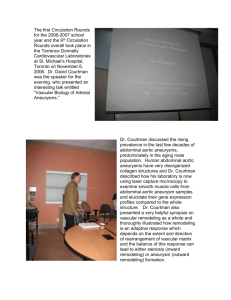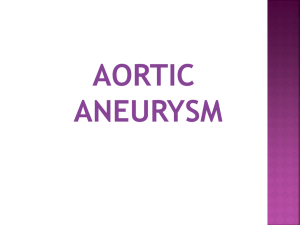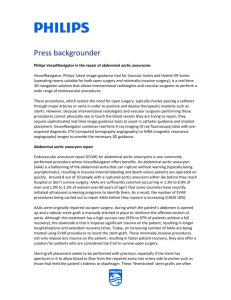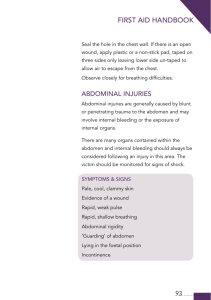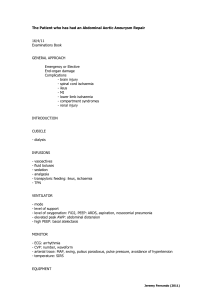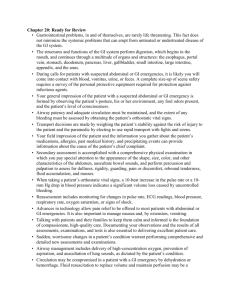Diagnostis in Emergency Medicine-An overview of strategies and a
advertisement
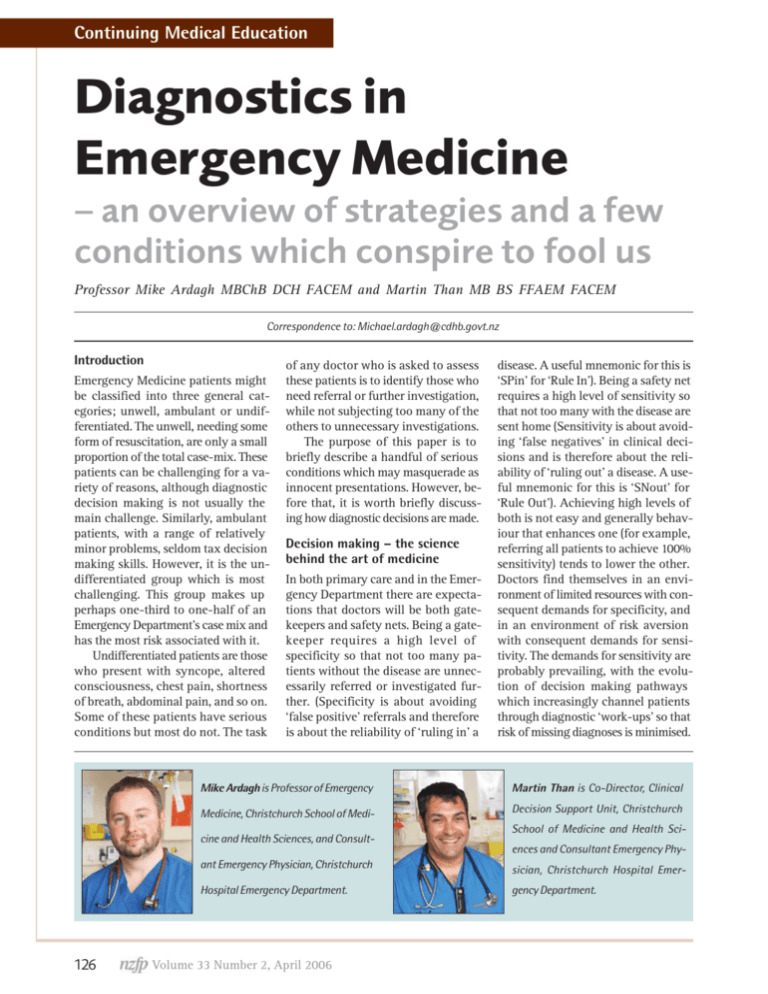
Continuing Medical Education Diagnostics in Emergency Medicine – an overview of strategies and a few conditions which conspire to fool us Professor Mike Ardagh MBChB DCH FACEM and Martin Than MB BS FFAEM FACEM Correspondence to: Michael.ardagh@cdhb.govt.nz Introduction Emergency Medicine patients might be classified into three general categories; unwell, ambulant or undifferentiated. The unwell, needing some form of resuscitation, are only a small proportion of the total case-mix. These patients can be challenging for a variety of reasons, although diagnostic decision making is not usually the main challenge. Similarly, ambulant patients, with a range of relatively minor problems, seldom tax decision making skills. However, it is the undifferentiated group which is most challenging. This group makes up perhaps one-third to one-half of an Emergency Department’s case mix and has the most risk associated with it. Undifferentiated patients are those who present with syncope, altered consciousness, chest pain, shortness of breath, abdominal pain, and so on. Some of these patients have serious conditions but most do not. The task of any doctor who is asked to assess these patients is to identify those who need referral or further investigation, while not subjecting too many of the others to unnecessary investigations. The purpose of this paper is to briefly describe a handful of serious conditions which may masquerade as innocent presentations. However, before that, it is worth briefly discussing how diagnostic decisions are made. Decision making – the science behind the art of medicine In both primary care and in the Emergency Department there are expectations that doctors will be both gatekeepers and safety nets. Being a gatekeeper requires a high level of specificity so that not too many patients without the disease are unnecessarily referred or investigated further. (Specificity is about avoiding ‘false positive’ referrals and therefore is about the reliability of ‘ruling in’ a disease. A useful mnemonic for this is ‘SPin’ for ‘Rule In’). Being a safety net requires a high level of sensitivity so that not too many with the disease are sent home (Sensitivity is about avoiding ‘false negatives’ in clinical decisions and is therefore about the reliability of ‘ruling out’ a disease. A useful mnemonic for this is ‘SNout’ for ‘Rule Out’). Achieving high levels of both is not easy and generally behaviour that enhances one (for example, referring all patients to achieve 100% sensitivity) tends to lower the other. Doctors find themselves in an environment of limited resources with consequent demands for specificity, and in an environment of risk aversion with consequent demands for sensitivity. The demands for sensitivity are probably prevailing, with the evolution of decision making pathways which increasingly channel patients through diagnostic ‘work-ups’ so that risk of missing diagnoses is minimised. Mike Ardagh is Professor of Emergency Martin Than is Co-Director, Clinical Medicine, Christchurch School of Medi- Decision Support Unit, Christchurch cine and Health Sciences, and Consult- School of Medicine and Health Sciences and Consultant Emergency Phy- 126 ant Emergency Physician, Christchurch sician, Christchurch Hospital Emer- Hospital Emergency Department. gency Department. Volume 33 Number 2, April 2006 Continuing Medical Education What we may have called the art of medicine is being turned into a science. Typically we will determine the likelihood of the patient having the disease based on an educated gut feeling. Of course this feeling is not without an evidence base. It is based on recognising a pattern of symptoms, signs and investigation results which we have seen before – an accumulated wisdom. The closeness of fit with the pattern we consider to represent the disease will allow us to ‘risk stratify’ the patient (at least subconsciously) into low, moderate or high likelihood of the disease. This ‘pattern recognition’ approach works well when a disease is common and always tends to present in a similar manner, but less well for rare diseases with varied and non-specific presentations. The accumulated wisdom of an experienced practitioner does not rate highly as a level of evidence in an age of enthusiasm for evidence-based medicine, but it should not be under appreciated and certainly not subject to disdain. It is this process that has enabled us to practise medicine well for generations and still is the principle level of evidence contributing to most decisions we make. However, we have an opportunity to augment this process with scientifically derived decision making strategies that effectively summarise the collective experience of hundreds or thousands of patient presentations. A sensible use of these strategies should be encouraged. Now there are a number of structured decision making tools which help us risk stratify for a variety of possible diagnoses. Generally these are derived from large studies of patients who might have the disease, some of whom subsequently have the disease ‘ruled in’ and the remainder have the disease ‘ruled out’. Then the factors which differentiate those who had the disease from those who did not, are ‘weighted’, ultimately producing a combination of clinical variables (symptoms, signs and possibly some investigation results) as a tool for ‘risk stratifying’ the patient. Risk stratifying is usually into low, moderate and high probability, each of which has a percentage likelihood of having the disease, based on the patients in these categories in the population studied. Then, the derived tool is validated prospectively on a cohort of patients. There are tools of this type for the diagnostic consideration of pulmonary embolism,1,2 deep venous thrombosis,3 acute coronary syndrome,4 and other conditions. Often these tools apply Bayesian reasoning to decision making, named after the theorem of Reverend Thomas Bayes (1702–1761). Bayes said ‘the interpretation of new information depends on what you believed beforehand.’ Or, in other words, ‘that given a particular test result, the probability of disease after the test depends on the probability before it is done.’ This process has two key components. First, the doctor ‘risk stratifies’ the patient based on the information to hand so far. For example, on the basis of the patient’s history the doctor may think the patient has a low risk of appendicitis as the cause of his abdominal pain. Then the doctor may modify the stratification of risk after the examination. After the results of investigations the doctor may modify the risk further. The risk stratification prior to the acquisition of more information is called the prior (or pre-test) probability. After further information is gathered the modified risk stratification is called the posterior (or post test) probability. The process continues until the physician and the patient are sufficiently happy with the likelihood of the disease that they either begin definitive care or they consider the likelihood so low that the disease is considered to be ‘ruled out’. However, there are some conditions that do not have a decision making tool for them and they may present with a misleading pattern so that our traditional pattern recognition is thwarted. What follows is a brief description of some such conditions. Traps and tips in the diagnosis of some serious conditions The following are a selection of serious conditions which have been missed because they did not follow a pattern recognised for that condition. Worse still they masqueraded as a more common and more benign condition. 1. Thoracic aortic dissection Trap: Musculoskeletal pain Background: Thoracic aortic dissection usually occurs as a combination of an intimal tear with blood then entering and splitting along the medial layer of the aorta, creating a false lumen. This is often associated with a history of hypertension or with some predisposing conditions such as Marfan’s syndrome and pregnancy. Presentation: Thoracic aortic dissection can involve the ascending aorta only, the descending only, or both. Ascending will often cause anterior pain. Descending typically produces a ‘tearing’ interscapular pain. Both may be associated with complications. Ascending may involve the aortic root and cause acute aortic valve incompetence or dissect into the pericardium causing tamponade. As the false lumen spreads through the medial layer the true lumens of aortic branches (particularly to upper limbs and head) may be pinched by the flow of blood in the false lumen around them. This pinching may cause ischaemia, which might manifest as focal neurological symptoms or signs, or an ischaemic upper limb. These ischaemic manifestations may resolve should flow through the aortic branch overcome the ‘pinching’ of the false lumen around it. Transient and migratory neurological or ischaemic manifestations are very suggestive of this diagnosis. However, sometimes the only manifestation of the condition is the sudden onset of severe upper back pain (sometimes described as neck pain). It is human nature to search for an explanation for unexplained events so the onset of pain may be linked to a coincident mechanical event such as lifting, straining or tripping. Volume 33 Number 2, April 2006 127 Continuing Medical Education Tip: Sudden onset of severe interscapular, upper back or lower neck pain, particularly if there is no convincing musculoskeletal cause, the pain seems out of keeping with a musculoskeletal cause, or there is a history of hypertension should warrant the consideration of thoracic aortic dissection and appropriate referral. 2. Ischaemic bowel Trap: Gastroenteritis Background: Loops of intestine can become ischaemic like any other tissue. Ischaemia can be embolic with sudden arterial occlusion. Emboli often arise from the mural thrombi of the poorly contracting atrium in a patient with atrial fibrillation or from atheromatous plaques. Pain in this case is severe and ‘visceral’. Because the mucosa of the intestine is the most demanding of blood supply it is the first to suffer. There may be shedding of mucosa with sometimes blood stained, diarrhoea. Because the pain is manifest via the autonomic innervation of the gut it is associated with nausea, is poorly localised, is often periumbilical and colicky. There is no peritoneal involvement at this stage, so the patient may be restless rather than lying still, and may have a soft abdomen with little tenderness. Only when the intestinal wall infarcts completely and the peritoneum becomes involved will the ‘somatic’ nervous system become involved with all the associated signs of peritonism. Venous ischaemia (where venous occlusion increases venous pressure, which impedes capillary flow and so on) may also occur, due to loops of bowel incarcerated in adhesions for example, or even due to primary venous thrombosis. The manifestations may be similar to arterial ischaemia, although possibly with less severe early symptoms. Tip: Patients with atrial fibrillation, severe atheromatous disease, or the elderly, with severe colicky abdominal pain should be considered to have ischaemic bowel even if the examination does not reveal peritonism. They should, at least, be watched very closely or referred appropriately. 3. Abdominal aortic aneurysm Trap: Renal colic Background: Ruptured abdominal aortic aneurysm often presents with back pain, radiating to the abdomen, and some form of collapse or evidence of shock. This presentation implies a rupture into the retroperitoneum with (a tenuous) tamponade of the bleeding. Rupture into the peritoneal cavity usually, at best, presents with pulseless electrical activity. However, occasionally an abdominal aortic aneurysm may have a smaller, contained bleed into one para-colic gutter of the retroperitoneal space. The patient’s ability to compensate for this amount of blood loss may mean that the presentation is without collapse or signs of shock. Instead the patient has unilateral back pain, possibly with some radiation anteriorly. There is no intra-peritoneal blood and therefore none of the manifestations of peritonism. Instead the patient is often restless and unable to find a comfortable position. Such presentations are well described5,6 and the patient may even have a urinalysis that is positive for blood. The cause of this is unknown but it may be a coincidental finding or it may be secondary to a ureter encased in haematoma. Tip: Older patients, particularly men and particularly if they have vascular disease, who present with apparent renal colic, should have abdominal aortic aneurysm considered. If a normal calibre aorta cannot be confirmed on examination then the patient should be referred for appropriate assessment and imaging. 4. Ectopic pregnancy Trap: A more benign cause of abdominal pain, gastroenteritis, or unexplained collapse. Background: Ectopic pregnancy varies in its presentation but it can present with life-threatening internal bleeding. Typically the patient is overdue for her menstrual period, although often the perceived time of the menstrual cycle is inconsistent. She develops abdominal pain as the very vascular pregnancy implanted in the tube outgrows the tube and begins to bleed. The pain is initially in the right or left iliac fossa and may become generalised as the patient develops peritonitis. Per vaginal bleeding may occur. Occasionally the light per vaginal blood loss reassures the treating physician that the 128 Volume 33 Number 2, April 2006 Continuing Medical Education bleeding is not major. These patients are typically young and fit and can compensate for blood loss for a good length of time prior to precipitous decompensation. Furthermore the per vaginal bleeding is not transmitted blood from the tubal pregnancy, but is, essentially, a period. As the tubal pregnancy dies it stops the hormonal support of the endometrium, which was preparing for implantation. The endometrium sheds and some per vaginal blood loss is noted. Meanwhile the internal bleeding can be major. Tip: Women of child bearing age, who develop abdominal pain, should have a pregnancy test done. If they are pregnant appropriate referral should be made to determine if the pregnancy is intra or extra uterine. If the diagnosis is suspected light or absent per vaginal bleeding should not reassure that there is little or no internal bleeding. It is expected that those for whom ectopic pregnancy is likely, and particularly any who show any signs of early shock, will be rapidly transferred to a hospital with the capacity to do life-saving surgery. This transfer should occur with appropriately skilled escorts. 5. Testicular torsion Trap: A more benign cause of abdominal pain. Background: One of the peaks of incidence of testicular torsion is early adolescence and it is in this group of patients that the diagnosis is missed with a degree of regularity. Typically testicular torsion causes sudden cessation of arterial flow to the testicle and consequent severe pain. The patient will indicate the source of the pain and decision making is not difficult. However, there are some who present with more subtle symptoms. The reason for this is not clear but it may be due to ‘venous ischaemia’ where the twisting of the vessels allows some arterial flow but occludes venous drainage. As venous pressure increases then it overcomes capillary, then arteriolar flow, resulting in an ischaemic testicle. The outcome is the same, although the presentation may be more subtle. If this subtle presentation is combined with a referral of pain to the lower abdomen and a shy References 1. Kline JA.Wells PS. Methodology for a rapid protocol to rule out pulmonary embolism in the emergency department Ann Emerg Med. 2003; 42:266-275. Chunilal SD, Eikelboom JW, Attia J, et al. Does this patient have pulmonary embolism? JAMA 2003; 290:2849-58 Anand SS, Wells PS, Hunt D, Brill-Edwards P, Cook D, Ginsberg JS. Does this patient have deep vein thrombosis? JAMA 1998; 2. 3. 4. 5. 6. adolescent who does not volunteer his testicles, then the diagnosis may be missed. Tip: Males who have lower abdominal pain should have their genitalia examined. Summary Medicine is an imprecise science. It has been compared to meteorology. With meteorology we can, with certain accuracy, say if it is sunny or raining right now, but it is more difficult to predict what this particular, somewhat non-specific, weather is going to turn into by the weekend. Like medicine, meteorology uses pattern recognition, flows, pressures, temperatures, and sophisticated imaging. Like medicine, meteorology is wrong some of the time. We should not deny this imprecision but we should try to be wrong as infrequently as we can. To this end it is worth remaining aware of the evolution of decision making tools, and those conditions that occasionally conspire to fool us. Competing interests None declared. 279:1094-1099 Panju A, Hemmelgarn BR, Guyatt GH, Simel DL, Durham NC. Is this patient having a myocardial infarction? JAMA. 1998; 280:1256-63 Lederle FA, Simel DL. Does this patient have abdominal aortic aneurysm? JAMA 1999; 281:77-82 Rogers RL, McCormack R. Aortic Disasters. Emergency Medicine clinics of North America. (2004) 22 (4). Emergencies presenting as musculoskeletal problems ‘Musculoskeletal injuries will rarely lead to a primary survey positive patient, except in major trauma. There are however immediately life threatening problems that might mimic a musculoskeletal condition. These pose a trap for the unwary and are listed below. • Leaking abdominal aortic aneurysm (AAA) presenting as back pain • Aortic dissection presenting as inter-scapular pain • Perforation/peritonitis presenting as shoulder tip pain • Acute myocardial infarction (MI) presenting as shoulder or arm pain A high index of suspicion and assessment of the ABCs can help identify these important conditions. A careful history will usually disclose no episode of trauma and a very acute onset of pain.’ FitzSimmons CR, Wardrope J.The ABC of community emergency care. 9 Assessment and care of musculoskeletal problems. Emerg Med J 2005; 22:68-76. Volume 33 Number 2, April 2006 129
